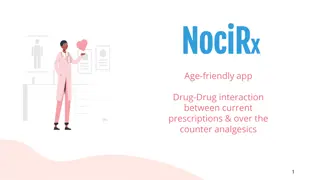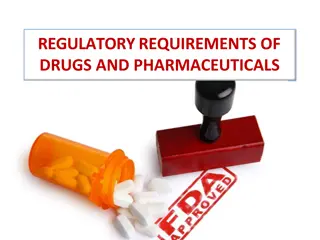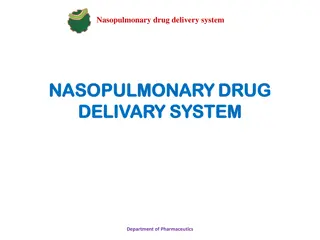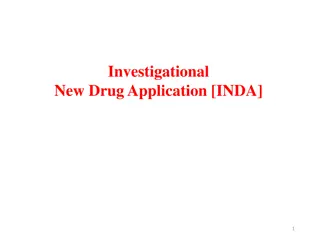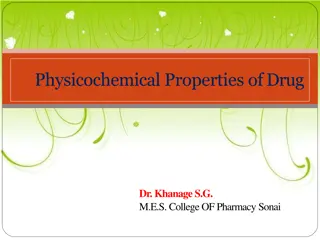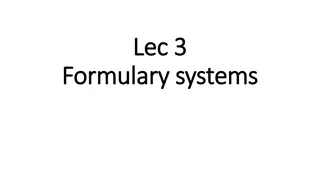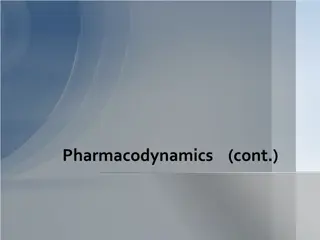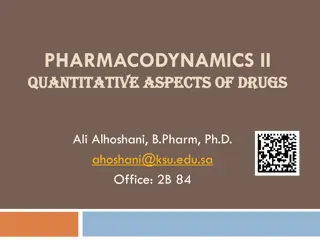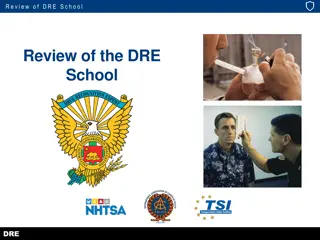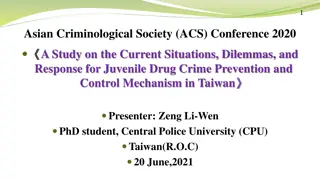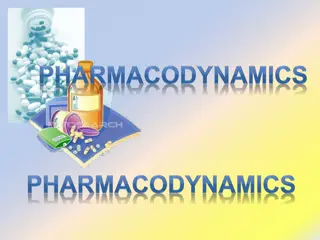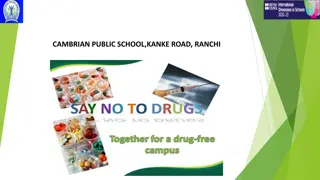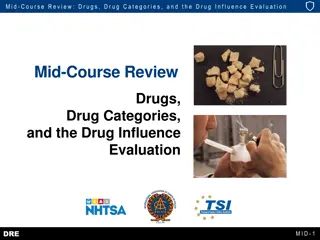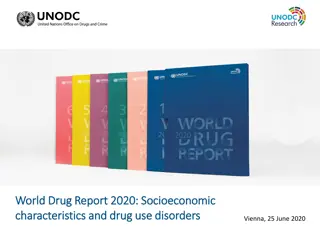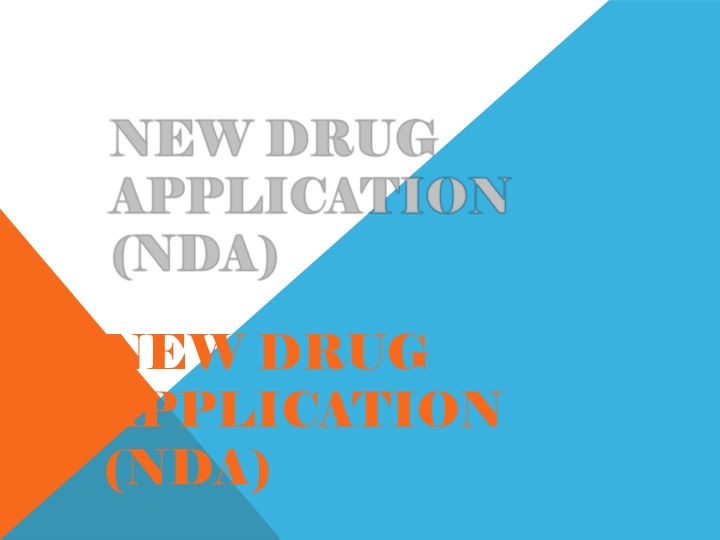
New Drug Application (NDA) and Drug Development Timeline
Explore the process and importance of the New Drug Application (NDA) submitted to the U.S. FDA for new drug market approval. Learn about the drug development timeline, NDA components, submission fundamentals, and NDA classifications by CDER.
Download Presentation

Please find below an Image/Link to download the presentation.
The content on the website is provided AS IS for your information and personal use only. It may not be sold, licensed, or shared on other websites without obtaining consent from the author. If you encounter any issues during the download, it is possible that the publisher has removed the file from their server.
You are allowed to download the files provided on this website for personal or commercial use, subject to the condition that they are used lawfully. All files are the property of their respective owners.
The content on the website is provided AS IS for your information and personal use only. It may not be sold, licensed, or shared on other websites without obtaining consent from the author.
E N D
Presentation Transcript
NEW DRUG APPLICATION (NDA)
DRUG DEVELOPMENT TIMELINE Discovery/Screening PRE-CLINICAL RESEARCH ANIMAL TESTING SYNTHESISAND PURIFICATION Avg.18 mon. IND Phase I Avg.5 yrs CLINICAL STUDIES Phase II Phase III NDA NDA Avg.12 month REVIEW Approval Adverse event survellance product defectreporting POST Survey sampling testing Post approval inspection MARKETING
NEW DRUG APPLICATION The New Drug Application (NDA) is an application submitted to U.S.FDA for permission to market a new drug product in the united states. The goals of the NDA are to provide enough information to permit FDAreviewers to establish thefollowing: 1. Whether the drug is safe and effective in its proposed use(s), and whether the benefits of the drug outweigh the risks? 2. Whether the drug s proposed labeling appropriate, and what should it contain? 3. Are the methods used in manufacturing (Good Manufacturing Practices; GMP) of the drug and the controls used to maintain the drug s quality adequate to preserve the drug s identity, strength, quality, and purity?
To legally gather this data on safety and effectiveness in the U.S., the maker must first obtain an Investigational New Drug (IND) designation from FDA. The documentation required in an NDA is supposed to tell the drug s whole story, including, What happened during the clinical tests, What the ingredients of the drug formulation are, The results of the animalstudies, How the drug behaves in the body, and How it is manufactured, processed and packaged. Once approval of an NDA is obtained, the new drug canbe legally marketed starting that day in the U.S.
FUNDAMENTALS FUNDAMENTALS OF OF NDA NDA SUBMISSIONS SUBMISSIONS Although the quantity of information and data submitted in NDAs can vary significantly. The components of any NDA are a function of the nature of the subject drug and the information available to the applicant at the time of submission. The form to use for either NDA or ANDA is Form FDA-356h, Application to Market a New Drug for Human Use or as anAntibiotic Drug for HumanUse.
NDA NDA CLASSIFICATIONS CLASSIFICATIONS CDER classifies new drug applications with a code that reflects both the type of drug being submitted and its intended uses. New MolecularEntity New Salt of Previously ApprovedDrug New Formulation of Previously ApprovedDrug New Combination of Two or MoreDrugs New Indication for Already Marketed Drug ,including switch in status to OTC (conversion of prescription drug toOTC) Already Marketed Drug Product without previously ApprovedNDA.
Fundamentals of NDA Submission As outlined in Form FDA-356h, Application to Market a New Drug for Human Use Or As An Antibiotic Drug For Human Use, NDAs can consist of as many as 15 different sections: Index Summary Chemistry, Manufacturing, and Control; Samples, Method Validation Package, and Labeling Nonclinical Pharmacology and Toxicology Human Pharmacokinetics and Bioavailability Microbiology (for anti-microbial drugs only); Clinical Data; Safety Update Report Statistical; Case Report Tabulations; Case Report Forms; Patent Information; Patent Certification; and Other Information.
NDA NDA REQUIRMENTS REQUIRMENTS (I) Content and format of application (I)Formatting, assembling and submitting new drug and antibiotic applications (I) NDA summary format andcontent (II) NDA technicalsections (III)Abbreviated new drug application
(I) (I) Content and format of application: Although the exact requirements are a function of the nature of a specific drug, the NDA must provide all relevant data and information that a sponsor has collected during the product's research and development.
(II) (II) Formatting, assembling and submitting new drug and antibiotic applications: A. A. Application Application format: format: The The NDA NDA regulations regulations require require the the submission submissionof of Archival Archival copy copy Review Reviewcopy. copy.
1. Archival copy: This is a complete copy of an application submission and is intended to serve as a reference source for FDAreviewers. This contains information which not contained in the review copy 2. Review copy: It is divided into five (or six) sections containing technical and scientific information required by FDA reviewers. Each of sections of review copy is separately bound. It should be provided with following: A copy of coverletter. A copy of application form (FDA356h) A copy of overallsummary A copy of index to the entireapplication An index to the specific review section Both copies are submitted in hard copy.
The review copy is divided into six technical sections ( review sections ) and should be submitted with each review section separately bound in a specific color: (i) Chemistry, Manufacturing and Controls (CMC) RED; (ii) Nonclinical Pharmacology YELLOW; (iii) Human Pharmacokinetics ORANGE; (iv) Microbiology (if required) WHITE; (v) Clinical Data LIGHT BROWN; (vi) Statistical GREEN. and T oxicology and Bioavailability
B.Assembling theapplication: : 1. Folders: Because of the procedure used at the FDA to file and retrieve material from the document rooms where applications are kept, it is necessary that applicants use the colored folders to bind the archival copy and each technical section. The cover of each folder should bear the NDA number (if known), name of applicant and name of drug product. 2. Paper size and binding: : All applications must be bound on the left side of the page using the Unite States standard size loose leaf page. (8.5 *11 ). 3. Pagination: All pages in the application must be numbered and numbering of review copy pages should be same as the numbering of corresponding pages in archival copy.
4. Volume size and identification: : Volume submitted in hard copy form should be no more than 2 inches thick. 5. Packing carton: The box size of 14 *12 *9.5 is recommended for shipment of applications to FDA. Because ANDAs are handled and stored separately, smaller boxes may be appropriate forthem. 6. Supplements, Amendments and Post marketing Reports: : The submission format for amendments to pending applications and supplements to approved applications will be same as an original application. Each submission will consist of two copies: a complete archival copy and an appropriately segmented review copy. Amendments, supplements, resubmissions annual reports and other correspondence concerning full applications should be addressed to appropriate FDAreviewing divisions.
(III) NDA SUMMARY FORMAT ANDCONTENT: Summary should provide sufficient detail. Data should be provided in tabular or graphical form,. Summary should be between 50- 200 pages. A. Annotated package insert: This section include proposed text of the labeling for the product. The proposed text of the package labeling must be annotated by referance to volume and page number to the information in the summary and in technical sections of the applications. B. Pharmacological class,scientific rationale,intended use and potential clinical benefits: A brief statement should be includded to identify the pharmacological class of the drug, the scientific rationale forthe drug, its intended use, and its potential clinical benefits.
C. Chemistry, Manufacturing and Controls: This summary must provide overview of the drug substances and the drug product. 1. Drug substance: It includes description about of drug substance, physical and chemical characteristics and stability of the drug substance. 2. Drug product: It includes information about: a. Composition and dosage form b. Name and address of manufacturer c. Container and closure system d. Stability e.Specifications for drug product and test methods to assure the specifications
D. Foreign Marketing History: If the product is marketed outside the U.S., regardless of the dosage form, strength, salt, ester, or complex of the drug, the marketing history should be provided. This should include a list of countries in which drug product is marketed, with dates of marketing, if known. It must also include a list of any countries in which the drug has been withdrawn for any reason relating to safety or efficacy. Specific reason for withdrawal should be given. E. Nonclinical Pharmacology and ToxicologySummary: It includes information about: 1. Pharmacology studies 2.Acute toxicity studies 3. Multi dose toxicity studies 4. Carcinogenicity studies 5. Special toxicity studies 6. Reproduction studies 7. Mutagenicity studies 8.ADME studies
F.Human Pharmacokinetics and Bioavailability Summary: It includes brief description about bioavailability study of drug, pharmacokinetic characteristic dissolution profile of drug. G. Microbiology Summary: It provides summary of results of the microbiologic studies conducted with anti-infective and antiviral drug. This includes mechanism of action, antimicrobial spectrum of action and mechanism of resistance to the drug. H. Clinical Data Summary and Results of StatisticalAnalysis: It is the basis of efficacy and safety that will determine an NDA approval. The Clinical Data Summary and Results of Statistical Analysis are divided into several parts as described below: Clinical pharmacology Overview of Clinical Studies Controlled Clinical Studies Uncontrolled Clinical Studies Other studies and Information Safety summary (general Safety Conclusions). of active ingredient and
( (IV) NDA technicalsections: This includes brief description of the followingsections. A. Chemistry, Manufacturing andControls: It is the most critical portion of NDA or ANDA .This section must fully describe the composition of the drug substance (active ingredient), and its synthesis (or isolation) and purification, as well as applicable process controls, specifications, and analytical testmethods.
C. Human Pharmacokinetics and BioavailabilitySection: For a new chemical entity (NCE), it is desirable to determine its bioavailability and pharmacokinetics from the dosage form, except that for certain dosage forms (e.g., iv solutions) 100% bioavailability may beassumed. For solid oral dosage forms (e.g., capsule or tablet) a bioequivalence study is often necessary to demonstrate that formulation proposed for marketing is bioequivalent to whatever formulations may have been employed in early clinical trial. The summary should include a table with following pharmacokinetic parameter: Cmax, AUC, Tmax, kel, Vd, plasma and renal clearance and urineexcretion. D. Microbiology: This section is of major importance for anti-infective drugs and includes data on the biochemical basis of the drug s action and its antimicrobial spectra; any known mechanisms of resistance to the drug; and clinical laboratorymethods.
E. Clinical Data Section: It is the most important and most complicated section of an NDA. It is the part that provides the safety and efficacy data on the drug for its intendeduse. F. Outline of Clinical Section: It includes 1. List of investigators; List of INDs and NDAs 2. Background / Overview of clinical investigations 3. Clinical pharmacology 4. Controlled clinical studies 5. Uncontrolled clinical studies 6. Other studies and information's 7. Integrated summary of efficacy 8. Integrated summary of safety 9. Drug abuse and over dosage information's 10. Integrated summary of benefits and risk of drugs
G. Samples, Methods Validation and Labeling: Samples should not be submitted to the FDA with theapplication. The reviewing chemist will contact the applicant and provide the laboratory address where samples should be sent. The applicant should prepare four representative samples in sufficient quantity to permit FDA to perform each test described in the application three times to determine whether the drug substance and drug product meet the specification given in the application. The archival copy of an application is required to contain copies of the label andall labeling proposed for the drug product.Methods-validation data must be-provided in triplicate because laboratories. copies are forwarded to two FDA H. Case Report Forms and Tabulations: The sponsor must submit data tabulations from each Phase II and Phase III study and also the case study report form for every clinical trial patient who died or withdrew from the study because of an adverseevent.
I. Patent Information: Information must be submitted regarding any patent held by the sponsor that covers the drug substance, formulation, and composition of the drug product, or method of use. Upon approval of the NDA, this information is published in the FDA s Orange Book (known formally as Approved Drug Products with Therapeutic Equivalence Evaluations) and serves as a guide to firms wishing to develop generic copies of the innovator s product. J. Patent Certification. Upon receipt of an NDA, the FDA conducts a review of the application to determine its completeness. Within 60 days, the FDA either accepts the filing or sends the applicant a refusal-to- file letter. If the applicant receives a refusal-to-file letter, they can request a conference with FDA.
Grounds for refusal to file the applicationinclude: Form FDA 356h has not beencompleted. The format of the application is not correct. One or more item is missing from the content as described in the regulations. The manufacturing facilities are not ready forinspection. Complete and accurate translations of all parts of the application not in English are not included. There are no statements regarding GLP compliance for each of the non clinical studies. There are no statements regarding compliance with IRB and informed consent regulations for each of the clinicalstudies. The drug product is already covered by an approved NDA orANDA.
Drug Sponsor NDA Application Filable? No Refuse to file letter issues Yes Reviewed by CDER Medical Pharmacology Chemistry Biopharmaceutical Statistical Microbiology Advisory Committee Meeting Meeting with Sponsor Review complete and acceptable
Additional info. Or Revision Requested or Submitted (Amendment) Review complete and acceptable No Sponsor revices Yes Applicant would ask to submit safety reports 4 months after initial submission Yes Pending satisfactory results No Yes No Labeling review Acceptable? Inspections of sites acceptable? NDA action
At this stage FDA will send one of three possible action letters to the applicant:- One possibility is a Not Approvable Letter, which will list the deficiencies in the NDA and explain why it cannot be approved. The second possibility is an Approvable Letter, which indicates that ultimately the drug product should be approved, but lists minor deficiencies and labeling changes that are needed before an approval. Requests for commitment for post-approval studies may be included. The third possibility is an Approval Letter, it states that the drug is approved. An applicant may receive both an Approvable Letter andApprovalLetter. Division director of CDER, signs and approve a letter that the product can be legally marketed, starting on that date

